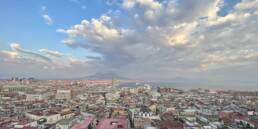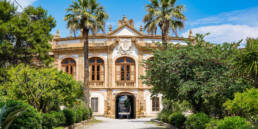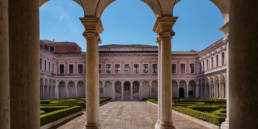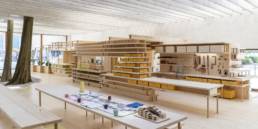Sometimes you don’t have to visit museums to experience culture. A stay at Hotel Armentarola in the Alto Adige is a relaxing opportunity to learn about Ladinian culture while eating, relaxing in the sun and doing invigorating sports.
This luxury boutique hotel in the Dolomites has 90% return customers… and I set out to find out why. I had the opportunity to speak with the owner of this family run hotel, Toni Weisser, and experience for myself the wonder of this place, the fruit of the labour of three generations of a hardworking family following the vision of one man who was crazy enough to build here.

Armentarola can hardly be called a town. It’s a few kilometers outside of San Cassiano in the Alto Adige, and it’s the first inhabited place you hit if you drive over the Falzarego pass on the Lagazuoi summit at 2778 meters. The drive over this mountain pass is a recommended approach, if there’s not too much snow, for it is truly beautiful.

The word “armenti” means sunny pasture, and this was where townspeople took their animals to pasture in the summer. In the 1930s, Toni’s grandparents were looking for a place to set up a hotel and they explored the furthest corners of the Dolomites, finally settling upon this one because it is one of the sunniest spots in the valley. Indeed, there are 7 hours of sun here even on the shortest days, plus mountains on all sides, an alpine stream, and direct access to the slopes. But it was also very remote. This did not stop the enterprising Mr. Weisser, who opened up the hotel in 1938 and went to the bus stop in La Villa every day to recruit guests and bring them back on his horse.

The Weissers are not the type of people to sit still, even now, three generations later. The current owner and his mother can be found performing normal tasks alongside the staff at any time of day – serving lunch or adjusting a flower display (the latter are truly beautiful and are all the creations of Mrs. Weisser). Back in the late 30s and 40s, this was a remote place, and money was scarce, but the hardworking family did everything themselves and earned fame through good service and good food, things that haven’t changed in over 70 years.


Over the years, of course the place has been expanded and modernized, growing into a hotel that blends local tradition with extremely good taste. The public areas are absolutely gorgeous with their modern decor and occasional antiques.

Our suite was huge, comfortable and perfectly silent. Incredible attention to detail is present in everything from the very soft sheets to the lovely personal fragrance developed for the bath amenities.


The Weissers define themselves as Ladinian, the culture of the four valleys of the Alto Adige with its own language and culinary tradition, and this culture shows up in a few ways in the hotel. The first is the food.
The day starts with the most impressive breakfast I have ever seen, and being North American, I have a healthy appreciation for breakfast. I only wish I could have had more time to sit there and eat all those multigrain breads, home-made jams, fresh fruits, cheeses and pastries…



Being vegetarian, I am never able to fully evaluate a chef’s abilities, though my husband exerted himself in sampling meats so I could photograph and show them to you! The hotel’s executive chef prepares an exquisite deer, for example, without a gram of fat and served with beautifully presented sides of vegetables and spatzle. Pasta and gnocchi are reinterpreted with mountain flavours, like watercress ravioli or radicchio gnocchi. Vegetables and fruit are not frowned upon here, and are lovingly prepared with excellent variety.

A dedicated pastry chef creates some of the most exquisite biscuits I have ever tasted (I personally love cookies more than any complex dessert), which are served liberally with tea, though the more complex desserts after lunch or dinner are works of art.

Speaking of art… Another aspect of the Ladinian culture that this place promotes is workmanship. On a daily basis, one sees this in the care with which the room is prepared, but before that, in the craftsmanship of the woodworking that dominates the decor, all in reappropriated fir wood from old local houses. This appreciation for sculpture extends to the opening of Galleria Unika, in 2007, in a part of the hotel previously used for a souvenir shop. The gallery gives local artists an opportunity to show their creations to the public in an area that has basically no art galleries (and few museums, too).

Finally, Ladinian culture, and that of the Dolomites more generally, is about wellness. The hotel’s full service spa is the perfect place to relax, either with a massage or just using the sauna, steam rooms, cold water grotto and relax area.

In a short stay at Armentarola, it’d be easy to never leave the hotel. But if forced to do so, there are plenty of things to do here year round, whether or not you love to ski. We took advantage of the location right on the hills of Alta Badia to snowboard without exerting ourselves too much… the views on a sunny day in this part of the Dolomites are spectacular and I felt just happy to take it in while taking it easy on the slopes. In the summer, hiking is an obvious choice, though the hotel also has stables for horse lovers.
The area’s history can be explored on skiis with a new itinerary dedicated to the first world war. 99 kilometers, of which 43 on skiis, take you to see some of the most spectacular views of the Dolomites and its mountains – Civetta, Pelmo, 5 Torri, Tofana, Lagazuoi, Conturines, Settsass, Sassongher, Sella and Marmolada. From May 24, 1915, to November, 1917, this area was a frontline at which the Italians for a while hoped to win the war. Along the path there are points of interest (trenches, galleries and encampments) constructed by soldiers on both sides during the Great War while fighting the enemy and the extreme elements.

Visitors wishing to learn more about Ladinian culture can do so at two area museums. In San Cassiano there’s a small museum dedicated to the Ursus Ladinicus, a now exinct cave dwelling bear whose bones were recently discovered nearby. The museum – a must for kids – contextualizes this bear within local nature (flora, fauna and the like) and also takes the opportunity to introduce visitors to local culture. About 40 minutes away is a related museum dedicated specifically to this culture which is explained through a series of dioramas and interactive displays (see www.museumladin.it).
One thing’s for sure in this sunny corner of the Dolomites: the service, the food, and the spectacular location steeped in local history makes for an unforgettable experience, one that I hope to repeat in the future.
Read more: for an interview with the hotel’s owners, please read ‘Meet the Owners: Toni Weisser‘ on Perfect Boutique hotel
Sign up to receive future blog posts by email
Alexandra Korey
Alexandra Korey aka @arttrav on social media, is a Florence-based writer and digital consultant. Her blog, ArtTrav has been online since 2004.
Related Posts
September 11, 2023
An art historian’s approach to things to do in Naples, Italy
June 22, 2023
4 day trips from Palermo up the Tyrrhenian coast
September 20, 2021




